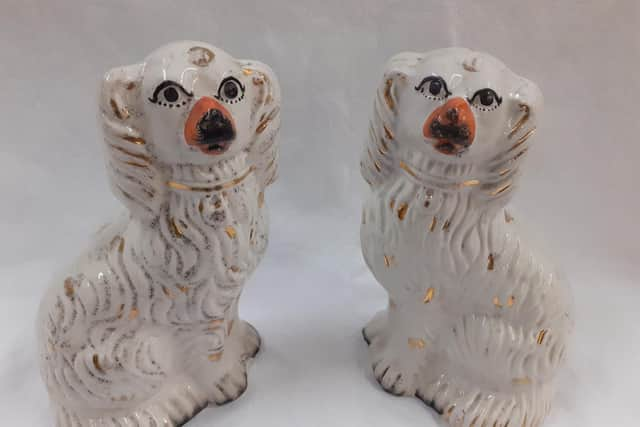Celebrate bring a dog to work day with this endearing pottery...
and live on Freeview channel 276
Will you be ‘taking your dog to work’ this Friday? Established in 2014, this annual event raises money for dog welfare charities, and is a visible reminder of how connected we are to our four legged friends.
Well behaved dogs are very welcome in the centre, and we have many ‘regulars.’ Another recognisable canine fixture in antiques centres countrywide are Staffordshire dogs. The epitome of Victoriana, these iconic charming pottery spaniels exemplify our love of animals and fondness for reproducing them, from prehistoric carvings onwards.
Advertisement
Hide AdAdvertisement
Hide AdThe Potteries produced dog figures from around 1720, with popularity and, therefore, production, peaking towards the end of the 19th century. By this time, no Victorian mantelpiece was complete without a bookending pair of soulful spaniels, hence their names: ‘hearth spaniels’ or ‘fireplace dogs’; look out for them also listed as ‘pot dogs’ or ‘china dogs’.


Relief-moulded versions known as ‘flatbacks’, designed to be sat on mantelpieces or flat against the fireplace, are particularly popular with collectors. The cream coloured earthenware (cream ware) was then painted and covered with a transparent glaze.
Due to the royal connection, King Charles Cavalier spaniels, like these pictured, were the most popular, and what one pictures when thinking of Staffordshire dogs. This splendidly well behaved pair are in the centre priced £55.
With thousands produced, prices depend on the piece’s authenticity and rarity, as well as its quality and condition. Crisp moulding, good decoration and fine detail will add to the piece’s value as much as its present condition. A well-regarded manufacturer’s name will also add value, but the majority of pieces were not marked. Of course, matched pairs in good condition are worth more than orphaned single dogs
Advertisement
Hide AdAdvertisement
Hide AdVery crude painting can denote either older, rarer 18th century pieces, or poorer quality later ones. You’ll need to check carefully as so many are reproductions. Older pieces have a hole in the back; the reason being that made by hand, the air hole would stop the piece collapsing. Also look for “Natural Crazing” which always denotes older pieces. More modern one have
“Printed Crazing”. Not sure what to look for? Printed is usually in straight lines and natural is all over.
So, you can see these old dogs have plenty of tricks when it comes to valuing, but strike it lucky and they could definitely become your new best friends!